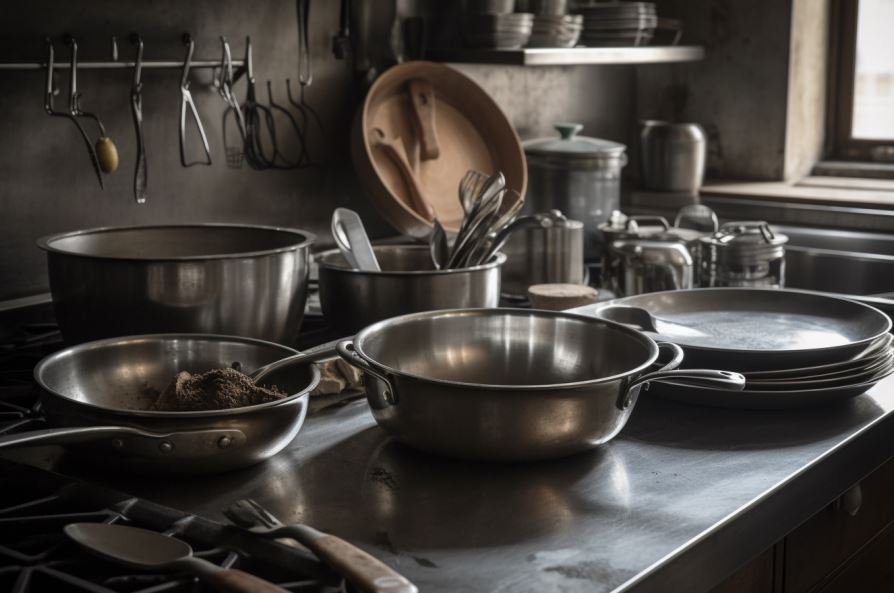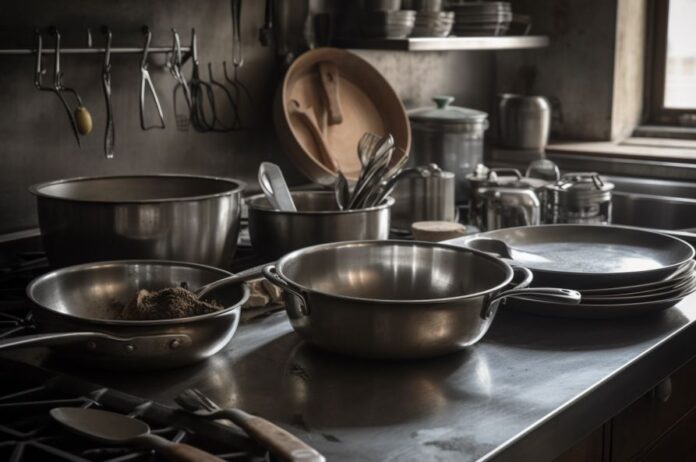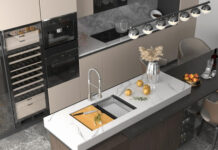Choosing the right cooking pan is essential for any cook who wants to prepare delicious meals. Different types of cooking pans have different properties that affect how food cooks and tastes.
The wrong type of cooking pan can ruin a dish, making it overcooked, undercooked, or even burned. Therefore, it’s important to choose a cooking pan that best suits your needs and preferences.

Overview of Stainless Steel and Cast Iron Pans
Stainless steel and cast iron are two of the most popular types of cooking pans used in kitchens all over the world. While these two materials may look similar at first glance, they have unique properties that set them apart from each other.
Stainless steel pans are made from a mixture of metals including chromium, nickel, and carbon. They are highly durable and long-lasting with non-reactive surfaces that do not transfer metal flavors or toxins to food when heated.
On the other hand, cast iron pans are made from molten iron that is poured into molds to create various shapes and sizes. These pans are known for their excellent heat retention, versatility in cooking options (they can be used on a stove, oven, or grill), and natural non-stick surface when seasoned properly, but also require seasoning before use.
See also: 7 Amazing Kitchen Upgrades On A Budget
Advantages of Stainless Steel and Cast Iron Pans
While both stainless steel and cast iron pans have their advantages and disadvantages; understanding these differences can help you make an informed decision when choosing a cooking pan suitable for your needs.
Advantages of Stainless Steel Pans
Durable and Long-Lasting
Stainless steel pans are known for their durability. They are resistant to scratches, dents, and other forms of damage.
Unlike cast iron pans, they do not rust or corrode easily, making them an excellent long-term investment. Even after years of use, stainless steel pans retain their shine and luster with proper care.
Non-Reactive Surface
Stainless steel is a non-reactive material which means it does not react chemically with acidic foods such as tomatoes or lemon juice. This feature makes it ideal for cooking delicate dishes that require precise pH levels since the pans won’t add any unwanted flavors to the food. Additionally, non-reactive surfaces are suitable for people with allergies because they don’t contain any harmful chemicals that could mix with the food.
Easy to Clean
Stainless steel pans are incredibly easy to clean due to their smooth surface. They don’t retain stains or odors from previous meals which means you can cook different dishes in them without worrying about cross-contamination. Most stainless steel pans are also dishwasher safe, saving you time and energy in cleaning up.
Disadvantages of Stainless Steel Pans
Poor Heat Distribution
Even though stainless steel is a good conductor of heat compared to other metals such as aluminum or copper, it still struggles to distribute heat evenly across its surface area. When cooking at high temperatures for an extended period of time, parts of the pan may become hotter than others creating hot spots that may lead to uneven cooking results.
Professional chef Ron Scott at Carnivorous Life mentions that if you’re trying to cook a steak to medium rare throughout the steak, you may have some trouble. There might be some areas that are a little over-cooked and others that are under-cooked due to the heat distribution of stainless steel which can lead to a less enjoyable steak.
Food May Stick To The Surface
One of the primary disadvantages of stainless steel cookware is its susceptibility to food sticking on its surface during cooking making it difficult sometimes when flipping stuff like eggs or pancakes. Its smooth surface doesn’t offer a non-stick quality, like cast iron or Teflon-coated cookware. To avoid this problem, it’s essential to use the right amount of oil in your cooking and to heat it up properly before adding the food. However, you should note that this issue isn’t a concern when searing meats since the sticking process are essential in achieving that crispy crust on the meat’s surface.
Advantages of Cast Iron Pans
Cast iron pans have been around for centuries and are known for their durability and ability to retain heat. These pans are made by pouring molten iron into a mold, resulting in a thick, heavy cooking surface that can last for generations. However, there are also some downsides to using cast iron pans.
Excellent heat retention
One of the most significant advantages of using a cast iron pan is its ability to retain heat. Once heated, the pan’s thick surface holds onto the heat, allowing for even cooking without hot spots. This feature makes it ideal for dishes that require high-heat cooking such as searing meat or frying chicken.
Versatile cooking options
Cast iron pans can be used on any stovetop (including induction), in the oven, or grill. This versatility makes it an excellent option for people who enjoy outdoor cooking but still want an indoor option.
Natural non-stick surface when seasoned properly
The non-stick surface is created through seasoning by applying oil or fat repeatedly over time until it creates a layer that protects food from sticking to the pan’s surface. Properly seasoned cast iron pans require very little oil or butter during cooking making them a healthier alternative to traditional non-stick cookware.
See also: 5 Kitchen Design Ideas For A Modern Appeal
Disadvantages of Cast Iron Pans
Heavy weight makes it difficult to handle for some people
The thickness that allows these pans to hold onto heat also makes them quite heavy, which can be challenging for some people with limited mobility or strength.
Requires seasoning before use
If not properly seasoned before use (or after cleaning), cast-iron pans can rust easily and lose their natural non-stick properties. New users may find this process overwhelming at first due to its unique requirements, but with some practice and patience, the seasoning process becomes more manageable.
While cast iron pans may seem intimidating to some users, their excellent heat retention, non-stick properties, and versatility make them an excellent option for any cook. With proper care and seasoning, these pans can last for generations and provide the perfect cooking surface for a wide range of dishes.
Comparison Between Stainless Steel and Cast Iron Pans
Heat Distribution
When it comes to heat distribution, cast iron takes the lead. This type of pan tends to hold onto heat longer than stainless steel, which means that your food will cook evenly and more efficiently. On the other hand, stainless steel pans are known for their poor heat distribution.
They can develop hot spots that can lead to overcooking or undercooking certain parts of your dish. However, some high-end stainless steel pans have aluminum or copper cores or cladding that improve their heat distribution.
Non-Stick Properties
Cast iron pans are naturally non-stick after being seasoned properly with oil or fat. This seasoning process forms a thin layer on the surface of the cast iron pan that helps prevent food from sticking. On the other hand, while stainless steel pans are generally easy to clean, they do not have any non-stick properties on their own.
However, non-stick coatings pose some health risks when used at high temperatures (over 500°F) due to toxic fumes emitted by the chemical decomposition of the coating material. Ultimately – while cast iron pans’ natural non-stick properties may be appealing – it’s worth noting that maintaining a properly seasoned cast iron pan requires effort and care on behalf of its owner.
In Summary
If you’re looking for even heating across all surfaces while cooking tough cuts of meat that require searing before simmering (like roasts), then go for a well-seasoned cast-iron skillet.
Alternatively, if you’re looking for a pan that’s easy to clean and maintain and whose non-reactive surface won’t alter the flavor of acidic foods (like tomatoes), then stainless steel is probably the better choice. After all, the right pan can make all the difference when it comes to cooking delicious meals in your kitchen.























